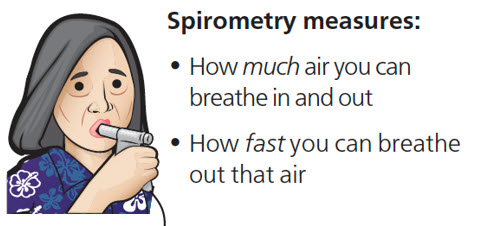Stages of COPD
Some of the most common questions asked by people with COPD are: "What are the stages of COPD?" "What stage am I in now?" and "What can I expect in the future?"
Well, the answer is not as clear-cut as it used to be because we’re learning more and more that COPD is not a "one-size-fits-all" disease.
The severity stages of COPD have been based on the results of a spirometry / lung function test which assesses how your lungs function compared to values of healthy people your age, race, and height. While it’s important to have a spirometry test and know your % predicted values of FEV1 and your FEV1/FVC ratio (these terms are explained below), that doesn’t tell us everything about how your health and symptoms will progress over the next few years.
Different “Types” of COPD
We know now that there are different "types" of COPD. Each type may affect how well different treatments work and how your symptoms, like shortness of breath, may progress. Other health conditions can also affect your COPD. These conditions, called “comorbidities” can include heart disease, diabetes, depression or anxiety, high blood pressure, and more. Thee health conditions can make your COPD worse. It is important to treat both your COPD and your comorbidities.
What are FEV1 and FVC?
Spirometry is a simple, non-invasive test that is used to diagnose COPD. When you take the test, you will be asked to blow all the air out of your lungs into a mouthpiece connected to a machine known as a spirometer. The technician tells you to take in a really deep breath, blast it out fast, then keep blowing and blowing as long as possible.
The machine will calculate two numbers, the amount of air you blow out in the first second, and the amount of air you can completely blow out and compare it to the values of a person your age, your height, and your race, with normal, healthy lungs.
These numbers are represented as FEV1 and FVC. FEV1 stands for the forced expiratory volume in the first second — the amount of air you forcefully exhaled in the first second of blowing. FVC stands for forced vital capacity— the amount of air that you completely exhale in one breath.

Lung Function Doesn’t Tell Us Everything
Let’s say there are three people, John, Sue, and Dave. They all have a FEV1 of 35% of predicted for their age and sex. You might think they all have similar symptoms or are impacted by COPD in the same way. But, in reality, their ability to do physical activities, their tendency to have COPD flare-ups (exacerbations) and even their level of blood oxygen (oxygen saturation number on a pulse oximeter) may be very different. John might be able to walk farther than Sue, but every time he gets a cold, it becomes a COPD exacerbation that really knocks him down. Sue hasn’t been really sick with breathing problems (had an exacerbation) for a few years. John and Sue’s oxygen saturation numbers are good, but Dave’s numbers get low when he walks, so he uses supplemental oxygen. With his oxygen, Dave can walk farther than John and Sue. How can that be?
It’s because spirometry numbers are just one aspect of determining what’s going on with your COPD and what kind of impact it has on your everyday life.
What Other Things Tell Us About Your COPD?
Here are some things that may help determine if you have one of the known types of COPD. Knowing these can be useful information in addition to knowing your spirometry numbers.
- If you have shortness of breath, is it at rest or only with exertion?
- As your COPD progresses, your shortness of breath may worsen; but for many people, this can be improved with regular activity or by attending pulmonary rehabilitation.
- Do you have a cough? If so, do you cough up sputum on most days for at least three months in a period of at least two years?
- This suggests that you may have chronic bronchitis, a type of COPD which may respond to different medicines.
- Do you have a lower oxygen level at rest, only with exertion, or when you sleep?
- Did your chest x-ray show hyperinflation or a flattened diaphragm?
- These changes can be from emphysema, which is diagnosed by a radiology test (a chest X-ray or a computed tomography [CT] scan). Emphysema can affect how your COPD progresses and what treatments may help. Sometimes it is possible to improve the hyperinflation of your lungs.
- Do you have any chronic conditions in addition to COPD (known as “comorbidities”), such as heart disease, diabetes, anxiety, or depression?
- No matter what your lung function is, treating your other conditions and getting them under control can improve what is happening with your COPD.
All these factors can have a significant impact on your everyday life. All should be taken into account to find the best way to manage your particular type of COPD. Remember, we do use the FEV1 and other lung function numbers to guide recommendations for care of your COPD.
To learn more about spirometry, stages of COPD, and current guidelines for treating COPD, visit the GOLD website at https://goldcopd.org/
Summary
COPD is not a "one-size-fits-all" disease. These levels, or stages, of COPD are just a broad guide to help you and your health care provider consider different types of treatment. Remember, all decisions must be based on your situation, your symptoms, and the total picture of you. There are several different factors that go into helping you and your health care provider understand what type of COPD you have and how best to treat it and manage it. Yes, COPD is progressive, and currently incurable. But it is very treatable and many people with COPD can live a long time, enjoying life, even with advanced disease.